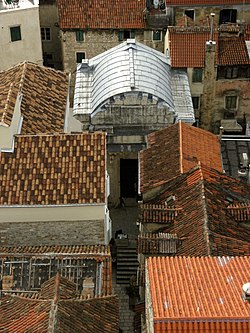User:Saxum/Temple of Jupiter, Split
Appearance
43°30′30″N 16°26′22″E / 43.50833°N 16.43944°E
| Temple of Jupiter | |
|---|---|
 | |
| General information | |
| Town or city | Split |
| Country | |
| Construction started | 295 AD |
| Completed | 305 AD |
| Client | Emperor Diocletian |
The temple of Jupiter (Croatian: Jupiterov hram) is an ancient Roman temple located in the western part of the Diocletian's Palace in Split, Croatia. Dedicated to Jupiter, the Roman god of sky and thunder, the temple was built during the construction of the palace between 295 and 305 AD. However, its fast-paced construction because of the emperor's imminent arrival at the palace, resulted in some of its elements remaining uncompleted while also creating constructional flaws in the process.
After the emperor's death in 313 AD, the palace and its temple became government property.
History[edit]
Baptismal font[edit]

x

x
x.
Sarcophagi[edit]

Ivan

x

x
The three sarcophagi located in (left and center image) and in front (right image) of the temple.
Sphinx[edit]
Footnotes[edit]
References[edit]
- Babić, Ivo (2011). "O reljefu s prikazom kralja iz Splitske krstionice" [About the Relief With the Image of a King From the Split Baptistery]. Archaeologia Adriatica. 4 (1): 203–215. Retrieved 26 May 2017.
- Nkšić, Goran (2004). "Jupiter Rising - Restoring Diocletian's Diminutive Temple of Jupiter" (PDF). wmf.org. World Monuments Fund. Retrieved 22 May 2017.
- Piplović, Stanko (June 1994). "Prva crkva u Dioklecijanovoj palači" [The First Church in the Diocletian's Palace]. Croatica Christiana Periodica. 18 (33): 101–108. Retrieved 22 May 2017.
- Piplović, Stanko (December 2016). "Dioklecijanova palača u Splitu nakon Careve smrti" [Diocletian’s Palace in Split after the Emperor’s death]. Vjesnik Za Arheologiju I Povijest Dalmatinsku. 109 (1): 259–290. Retrieved 23 July 2017.
